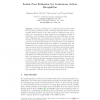Free Online Productivity Tools
i2Speak
i2Symbol
i2OCR
iTex2Img
iWeb2Print
iWeb2Shot
i2Type
iPdf2Split
iPdf2Merge
i2Bopomofo
i2Arabic
i2Style
i2Image
i2PDF
iLatex2Rtf
Sci2ools
ECCV
2008
Springer
2008
Springer
Latent Pose Estimator for Continuous Action Recognition
Recently, models based on conditional random fields (CRF) have produced promising results on labeling sequential data in several scientific fields. However, in the vision task of continuous action recognition, the observations of visual features have dimensions as high as hundreds or even thousands. This might pose severe difficulties on parameter estimation and even degrade the performance. To bridge the gap between the high dimensional observations and the random fields, we propose a novel model that replace the observation layer of a traditional random fields model with a latent pose estimator. In training stage, the human pose is not observed in the action data, and the latent pose estimator is learned under the supervision of the labeled action data, instead of image-to-pose data. The advantage of this model is twofold. First, it learns to convert the high dimensional observations into more compact and informative representations. Second, it enables transfer learning to fully util...
Computer Vision | Conditional Random Fields | ECCV 2008 | Human Pose | Latent Pose Estimator | Random Fields Model | Standard Crf Model |
Related Content
| Added | 15 Oct 2009 |
| Updated | 15 Oct 2009 |
| Type | Conference |
| Year | 2008 |
| Where | ECCV |
| Authors | Huazhong Ning, Wei Xu, Yihong Gong, Thomas S. Huang |
Comments (0)

